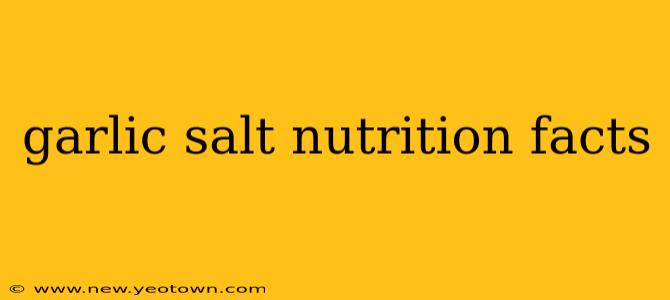Garlic salt. That magical blend of savory garlic and salty crystals that elevates everything from roasted vegetables to popcorn. But have you ever stopped to consider what's really in that little shaker? This isn't just about sodium; it's a complex mix of nutrients and flavors with potential benefits and considerations. Let's unravel the nutritional facts of garlic salt and explore some common questions.
What are the main ingredients in garlic salt?
The simplest answer is garlic and salt. However, the specific proportions and the type of salt used can vary significantly between brands. Some garlic salts might contain additional ingredients like anti-caking agents (to prevent clumping) or dehydrated garlic powder instead of fresh garlic. This affects the overall nutritional profile. Reading the ingredient list on your specific brand is key to understanding its exact composition.
How much sodium is in garlic salt?
This is a crucial question for many, as sodium intake is closely monitored for health reasons. The sodium content is heavily influenced by the salt-to-garlic ratio. Generally, garlic salt is quite high in sodium. A typical teaspoon can contain anywhere from 700mg to over 1000mg of sodium. This is a significant portion of the recommended daily allowance for many adults, which is often capped at 2300mg. Therefore, moderation is essential when using garlic salt.
What are the other nutrients in garlic salt?
Beyond sodium, garlic itself brings a wealth of potential health benefits to the table. While the amounts are relatively small in a serving of garlic salt due to the salt’s dominance, garlic contains:
- Allicin: A potent compound with antioxidant and anti-inflammatory properties. However, it's important to note that the processing of garlic into salt may reduce the allicin content.
- Manganese: An essential mineral involved in bone health and metabolism.
- Vitamin C: An antioxidant that supports immune function (though the amount in garlic salt is generally low).
- Vitamin B6: Important for brain development and function.
Does garlic salt have any health benefits?
The health benefits mainly stem from the garlic content. While the allicin content might be diminished during processing, the small amounts of other nutrients contribute to overall dietary intake. Some studies suggest garlic can help lower blood pressure and cholesterol, boost immunity, and even have potential anti-cancer properties. However, it's crucial to remember that these benefits are largely associated with consuming significant amounts of fresh garlic, not just a sprinkle of garlic salt.
Is garlic salt the same as garlic powder?
No, garlic salt and garlic powder are different. Garlic powder is simply dehydrated garlic, whereas garlic salt is a mixture of garlic (powder or flakes) and salt. Garlic powder will have significantly less sodium.
How can I reduce my sodium intake when using garlic salt?
- Use it sparingly: A little goes a long way with garlic salt's potent flavor.
- Choose low-sodium varieties: Some brands offer garlic salt with reduced sodium content.
- Experiment with alternatives: Consider using fresh garlic, garlic powder, or other herbs and spices to add flavor without the excess sodium.
Garlic salt, despite its deliciousness, needs to be approached with mindful awareness of its high sodium content. While it offers a dash of garlic's potential health benefits, moderation is key to enjoying this flavorful seasoning without compromising your health goals. Remember to always check the nutrition facts label on your specific brand for the most accurate information.

